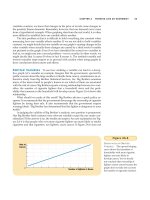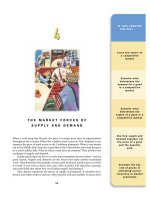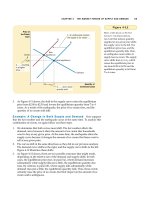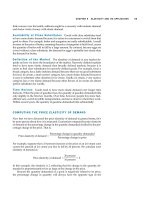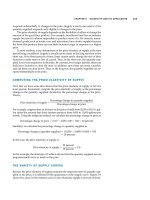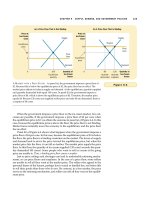Tài liệu Ten Principles of Economics - Part 57 pptx
Bạn đang xem bản rút gọn của tài liệu. Xem và tải ngay bản đầy đủ của tài liệu tại đây (246.22 KB, 10 trang )
IN THIS CHAPTER
YOU WILL . . .
Examine how
unemployment
results when firms
choose to pay
efficiency wages
Consider how
unemployment can
result from
minimum-wage laws
Learn about the
data used to
measure the amount
of unemployment
Consider how
unemployment
arises from the
process of job
search
See how
unemployment can
arise from
bargaining between
firms and unions
Losing a job can be the most distressing economic event in a person’s life. Most
people rely on their labor earnings to maintain their standard of living, and many
people get from their work not only income but also a sense of personal accom-
plishment. A job loss means a lower living standard in the present, anxiety about
the future, and reduced self-esteem. It is not surprising, therefore, that politicians
campaigning for office often speak about how their proposed policies will help
create jobs.
In the preceding two chapters we have seen some of the forces that determine
the level and growth of a country’s standard of living. A country that saves and in-
vests a high fraction of its income, for instance, enjoys more rapid growth in its
capital stock and its GDP than a similar country that saves and invests less. An
even more obvious determinant of a country’s standard of living is the amount of
unemployment it typically experiences. People who would like to work but cannot
UNEMPLOYMENT
AND ITS NATURAL RATE
579
580 PART NINE THE REAL ECONOMY IN THE LONG RUN
find a job are not contributing to the economy’s production of goods and services.
Although some degree of unemployment is inevitable in a complex economy with
thousands of firms and millions of workers, the amount of unemployment varies
substantially over time and across countries. When a country keeps its workers as
fully employed as possible, it achieves a higher level of GDP than it would if it left
many of its workers standing idle.
This chapter begins our study of unemployment. The problem of unemploy-
ment is usefully divided into two categories—the long-run problem and the short-
run problem. The economy’s natural rate of unemployment refers to the amount of
unemployment that the economy normally experiences. Cyclical unemployment
refers to the year-to-year fluctuations in unemployment around its natural rate,
and it is closely associated with the short-run ups and downs of economic activity.
Cyclical unemployment has its own explanation, which we defer until we study
short-run economic fluctuations later in this book. In this chapter we discuss the
determinants of an economy’s natural rate of unemployment. As we will see, the
designation natural does not imply that this rate of unemployment is desirable.
Nor does it imply that it is constant over time or impervious to economic policy. It
merely means that this unemployment does not go away on its own even in the
long run.
We begin the chapter by looking at some of the relevant facts that describe un-
employment. In particular, we examine three questions: How does the govern-
ment measure the economy’s rate of unemployment? What problems arise in
interpreting the unemployment data? How long are the unemployed typically
without work?
We then turn to the reasons why economies always experience some unem-
ployment and the ways in which policymakers can help the unemployed. We dis-
cuss four explanations for the economy’s natural rate of unemployment: job
search, minimum-wage laws, unions, and efficiency wages. As we will see, long-
run unemployment does not arise from a single problem that has a single solution.
Instead, it reflects a variety of related problems. As a result, there is no easy way
for policymakers to reduce the economy’s natural rate of unemployment and, at
the same time, to alleviate the hardships experienced by the unemployed.
IDENTIFYING UNEMPLOYMENT
We begin this chapter by examining more precisely what the term unemployment
means. We consider how the government measures unemployment, what prob-
lems arise in interpreting the unemployment data, and how long the typical spell
of unemployment lasts.
HOW IS UNEMPLOYMENT MEASURED?
Measuring unemployment is the job of the Bureau of Labor Statistics (BLS), which
is part of the Department of Labor. Every month the BLS produces data on unem-
ployment and on other aspects of the labor market, such as types of employment,
CHAPTER 26 UNEMPLOYMENT AND ITS NATURAL RATE 581
length of the average workweek, and the duration of unemployment. These data
come from a regular survey of about 60,000 households, called the Current Popu-
lation Survey.
Based on the answers to survey questions, the BLS places each adult (aged six-
teen and older) in each surveyed household into one of three categories:
◆ Employed
◆ Unemployed
◆ Not in the labor force
A person is considered employed if he or she spent most of the previous week
working at a paid job. A person is unemployed if he or she is on temporary layoff,
is looking for a job, or is waiting for the start date of a new job. A person who fits
neither of the first two categories, such as a full-time student, homemaker, or re-
tiree, is not in the labor force. Figure 26-1 shows this breakdown for 1998.
Once the BLS has placed all the individuals covered by the survey in a cate-
gory, it computes various statistics to summarize the state of the labor market. The
BLS defines the labor force as the sum of the employed and the unemployed:
Labor force ϭ Number employed ϩ number of unemployed
Adult
population
(205.2 million)
Labor force
(137.7 million)
Employed
(131.5 million)
Not in labor force
(67.5 million)
Unemployed (6.2 million)
Figure 26-1
T
HE
B
REAKDOWN OF THE
P
OPULATION IN
1998. The
Bureau of Labor Statistics
divides the adult population
into three categories: employed,
unemployed, and not in the
labor force.
S
OURCE
: Bureau of Labor Statistics.
labor force
the total number of workers,
including both the employed
and the unemployed
582 PART NINE THE REAL ECONOMY IN THE LONG RUN
The BLS defines the unemployment rate as the percentage of the labor force that
is unemployed:
Unemployment rate ϭϫ 100.
The BLS computes unemployment rates for the entire adult population and for
more narrow groups—blacks, whites, men, women, and so on.
The BLS uses the same survey to produce data on labor-force participation.
The labor-force participation rate measures the percentage of the total adult pop-
ulation of the United States that is in the labor force:
Labor-force participation rate ϭϫ 100.
This statistic tells us the fraction of the population that has chosen to participate in
the labor market. The labor-force participation rate, like the unemployment rate, is
computed both for the entire adult population and for more narrow groups.
To see how these data are computed, consider the figures for 1998. In that year,
131.5 million people were employed, and 6.2 million people were unemployed.
The labor force was
Labor force ϭ 131.5 ϩ 6.2 ϭ 137.7 million.
The unemployment rate was
Unemployment rate ϭ (6.2/137.7) ϫ 100 ϭ 4.5 percent.
Because the adult population was 205.2 million, the labor-force participation
rate was
Labor-force participation rate ϭ (137.7/205.2) ϫ 100 ϭ 67.1 percent.
Hence, in 1998, two-thirds of the U.S. adult population were participating in the
labor market, and 4.5 percent of those labor-market participants were with-
out work.
Table 26-1 shows the statistics on unemployment and labor-force participation
for various groups within the U.S. population. Three comparisons are most appar-
ent. First, women have lower rates of labor-force participation than men, but once
in the labor force, women have similar rates of unemployment. Second, blacks
have similar rates of labor-force participation as whites, and they have much
higher rates of unemployment. Third, teenagers have lower rates of labor-force
participation and much higher rates of unemployment than the overall popula-
tion. More generally, these data show that labor-market experiences vary widely
among groups within the economy.
The BLS data on the labor market also allow economists and policymakers to
monitor changes in the economy over time. Figure 26-2 shows the unemployment
rate in the United States since 1960. The figure shows that the economy always has
some unemployment and that the amount changes from year to year. The normal
rate of unemployment around which the unemployment rate fluctuates is called
the natural rate of unemployment, and the deviation of unemployment from its
Labor force
Adult population
Number of unemployed
Labor force
unemployment rate
the percentage of the labor force
that is unemployed
labor-force
participation rate
the percentage of the adult
population that is in the labor force
natural rate of
unemployment
the normal rate of unemployment
around which the unemployment
rate fluctuates
CHAPTER 26 UNEMPLOYMENT AND ITS NATURAL RATE 583
natural rate is called cyclical unemployment. In the figure, the natural rate is
shown as a horizontal line at 5.5 percent, which is a rough estimate of the natural
rate for the U.S. economy during this period. Later in this book we discuss
U
NEMPLOYMENT
L
ABOR
-F
ORCE
D
EMOGRAPHIC
G
ROUP
R
ATE
P
ARTICIPATION
R
ATE
A
DULTS
(
AGES
20
AND OVER
)
White, male 3.2% 77.2%
White, female 3.4 59.7
Black, male 7.4 72.5
Black, female 7.9 64.8
T
EENAGERS
(
AGES
16–19)
White, male 14.1 56.6
White, female 10.9 55.4
Black, male 30.1 40.7
Black, female 25.3 42.5
S
OURCE
: Bureau of Labor Statistics.
Table 26-1
T
HE
L
ABOR
-M
ARKET
E
XPERIENCES OF
V
ARIOUS
D
EMOGRAPHIC
G
ROUPS
.
This table shows the
unemployment rate and
the labor-force participation
rate of various groups in the
U.S. population for 1998.
10
8
6
4
2
0
1970 19751960 1965 1980 1985 1990 2000
Percent of
Labor Force
1995
Natural rate of
unemployment
Unemployment rate
Figure 26-2
U
NEMPLOYMENT
R
ATE SINCE
1960. This graph uses annual data on the unemployment
rate to show the fraction of the labor force without a job.
Source: U.S. Department of Labor.
cyclical unemployment
the deviation of unemployment from
its natural rate
